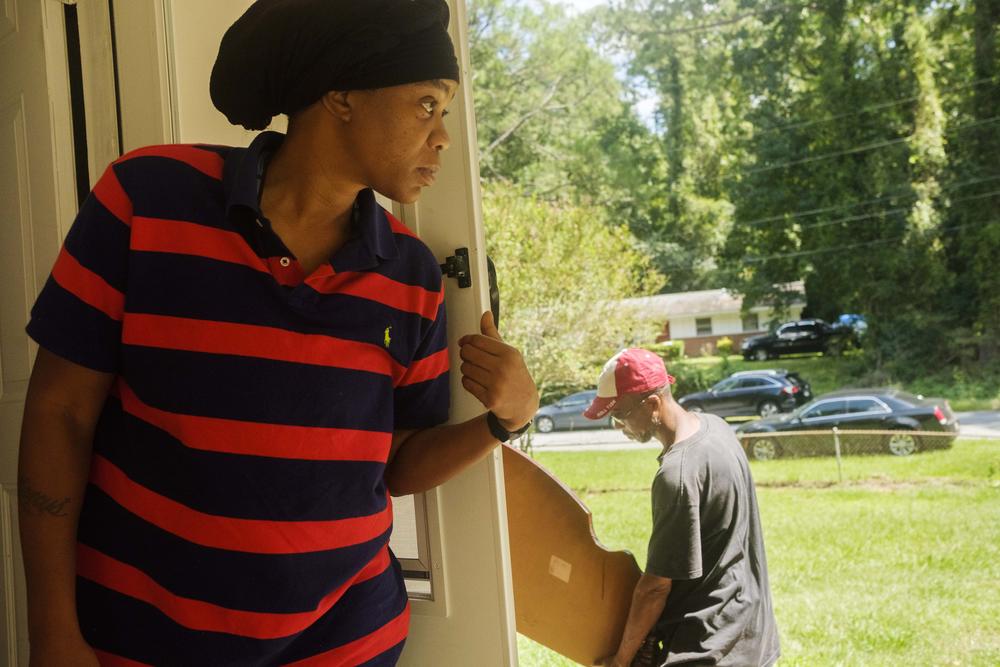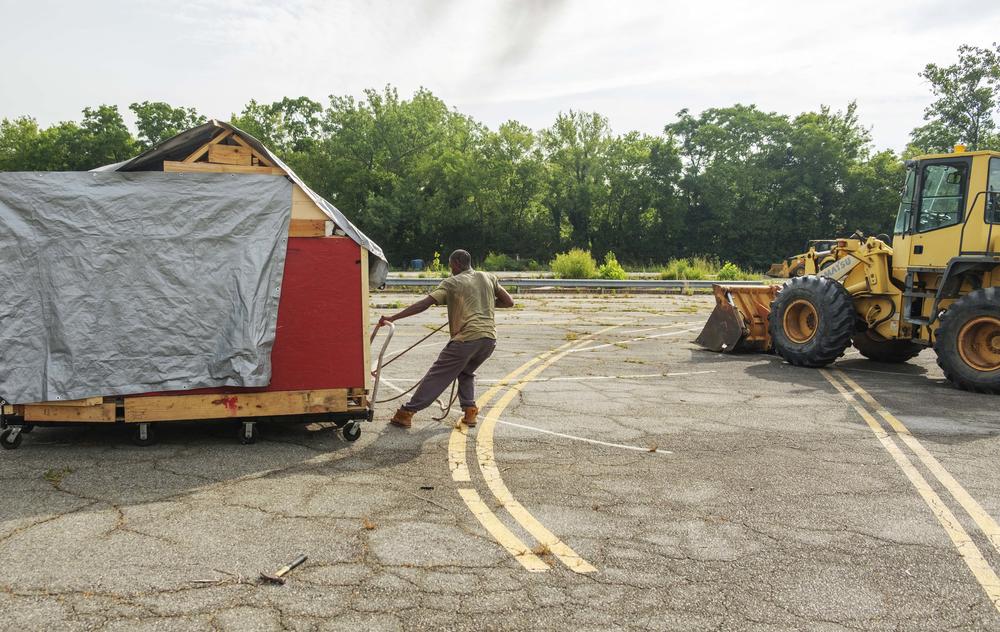
Caption
LaShundra Thomas in the doorway of her new home in Columbus. A string of deadbeat landlords in Atlanta left Thomas without adequate housing.
Credit: Grant Blankenship
LISTEN: After years of steady declines, levels of homelessness in the U.S. began rising again during the COVID-19 pandemic. Proven strategies are being used to reduce homelessness, even if they are facing new challenges. GPB's Grant Blankenship reports.
——
By the time moving day came, LaShundra Thomas was pretty exhausted.
“You got a king-sized bed; where do you want it?” asked one of the movers helping her into her new house.
“Stop it! Whichever way is fine with me,” Thomas joked. Then she made a snoring sound to explain her aim, whatever way the bed was oriented in the room.
Before Thomas moved into this home in Columbus with up-to-date flooring, new appliances and an extra bedroom so her sons don’t have to sleep in cramped quarters, she had run into an all-too-common predicament: She paid the rent on her Atlanta apartment, but her landlord didn’t hold up her end of the deal.
“She didn't really care to fix anything or nothing like that,” Thomas said.
Georgia’s general lack of renters’ rights left Thomas with one remedy: to break her lease. She did that, and tried a new apartment.
“My God. Those people took about $1,800 from me,” she said.
And so she left again and eventually Thomas found herself low on cash and homeless. Then she found help.
“I've never in my life seen anyone get help to this magnitude this fast," she said. “And this is a blessing; 100%. And those people really do care about people.”
“Those people” are the Home for Good Program, an arm of the United Way of the Chattahoochee Valley. They are helping Thomas with what’s called supportive housing. They will provide at least a year of rent for Thomas in her new home, maybe even longer.
Home for Good is also the name of a larger federation of other local nonprofit homelessness relief groups in Columbus.
The organization is one of hundreds across the country taking what may at first seem like a counterintuitive, or at least non-traditional, approach to reducing the population of unhoused people which, after years of steady declines, began rising again during the COVID-19 pandemic.

LaShundra Thomas in the doorway of her new home in Columbus. A string of deadbeat landlords in Atlanta left Thomas without adequate housing.
Pat Frey leads Home for Good in Columbus. She said getting nonprofit actors who had done what they felt was best for decades to break with tradition was not easy.
“It's a lot," Frey said. "And it's a lot of what we call breaking down of those silos. And it's not 'My client' and 'Your client' and 'Their client.' It's 'Our client.' It's our community member.”
Frey said the break in tradition can be summed up in a concept called “housing first.”
“You know, someone had to meet certain criteria and have certain things already in place to be, quote unquote, 'ready for housing,'” Frey said.
That was the old way: It meant someone could be expected to hold down a 9-5 job, even manage addiction or mental health issues, before being offered a leg up into housing.
The housing first model flips that. It assumes not only should everyone be offered housing, but that housing is the prerequisite for tackling those other challenges.
“This is huge," Frey said. "I mean, this is a time when you take a breath, the client can breathe a little bit and check some boxes off of their goals list.”
The housing first model has made national headlines when practiced in cities like Houston and Seattle, where it means skipping the traditional homeless shelter entirely.
“Historically they don't work super well,” Cathryn Vassell, head of Atlanta’s Partners for Home, said of brick and mortar shelters. “People are frequently just cycling in and out of the shelter system, either out of one shelter into another shelter or out of shelter and onto the street.”
Like Frey’s group in Columbus, Partners for Home leads what the federal department of Housing and Urban Development calls a Continuum of Care program, or CoC.
HUD is bullish on the housing first model, so today that's where the HUD money is. Almost 400 other CoC organizations nationwide ask HUD for some piece of over $2.5 billion in funding every year.
“Those agencies have to compete for that funding, and they have to show demonstrable outcomes,” Vassell said.
Each individual member of a CoC has their own piece of the housing pipeline to tend to. One nonprofit may specialize in mental health counseling, another in rent support, others in education or job training.
Then those collaborations must prove to HUD they are making a difference.
“They no longer get those grants — a rubber stamp,” Vassell said. “They have to show what they're doing with the money and be able to demonstrate that those projects are performing well in order to get funded again.”
Vassell said, as in Columbus, it wasn’t easy getting Atlanta’s constellation of nonprofits to buy into the idea. Stakeholders wanted proof that housing first works.
“And the good news is there's a plethora of that available,” Vassell said.
HUD makes all the data reporting they demand from CoCs available to the public.
“It's like the Library of Congress for housing geeks,” Frey said of the HUD data. Through data collection, Frey knows the vast majority of the people who need housing support in and around Columbus are newly homeless and often are mothers with children.
Many groups, like Vassell’s Partners for Home, go the extra step and make their own data easily accessible on their own dashboards. Today Partners for Home data shows an over 30% drop in chronic street homelessness in Atlanta since 2019.

A man tries to pull his home out of the way of a heavy equipment-aided sweep of a homeless encampment in Macon in June.
Two years ago, 85 miles south, the city of Macon was shocked when two homeless men froze to death on Christmas Eve. A new shelter, now the Brookdale Resource Center, soon followed.
But today, Macon is the largest city in Georgia without a Continuum of Care. Only one local agency, the Macon-Bibb County Economic Opportunity Council, receives HUD funding for supportive housing, but that only amounts to about 15% of the federal funding the Columbus CoC receives.
All that could change.
On a recent afternoon meeting in a renovated mill village auditorium, Jake Hall told of local nonprofits, most of whom are used to doing their own thing, they need to unite.
“We're going to have to have an added layer to this conversation of how can we bust through some of the silos of care,” Hall said. He was just hired by the local United Way to coordinate these efforts.
Helping Hall with his pitch was Andrae Bailey. Bailey speaks to groups across the country about solutions to homelessness.
Bailey said when he sees change in a city, it’s always through a well-run Continuum of Care and by extension through HUD money, which he says, as tax money, is already ours.
“I've never seen a community be successful without having control of their local money that belongs to you and the decisionmaking on it,” Bailey said.
Back in Columbus where LaShundra Thomas is getting settled in, Frey agrees about the HUD funding.
“Oh, absolutely; there's no way we could do this," Frey said. "No way we could do this without it. You know, our community would be 10 years behind where we are now if we didn't have the federal funding.”
That’s even with the best intentions of local philanthropy, she said.
It would be too easy, though, to think of a Continuum of Care as a cure-all.
Both Frey in Columbus and Vassell in Atlanta agree that money to help with rent only works when there is affordable housing available, and that is increasingly in short supply.